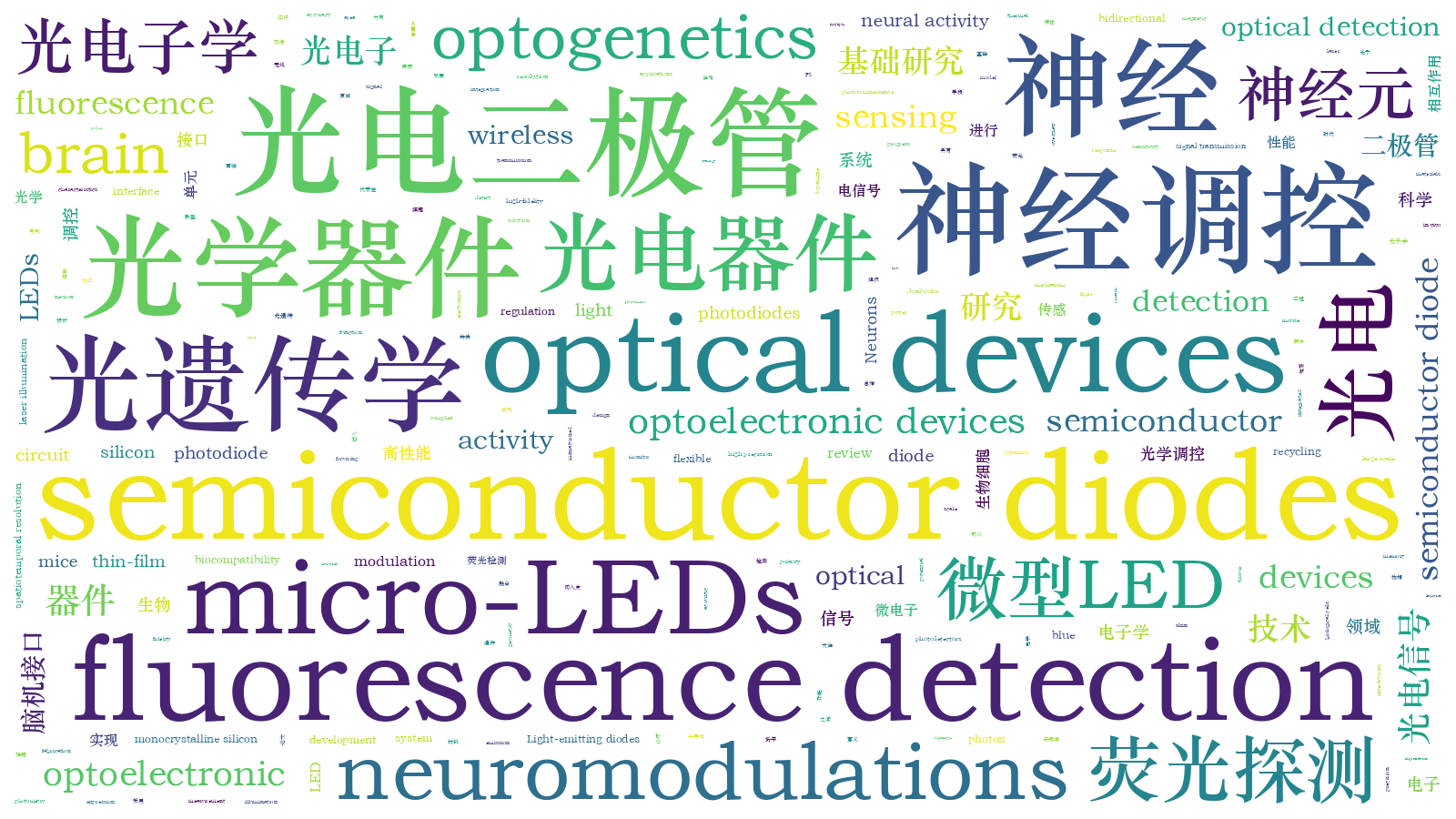脑机接口技术的基础研究:神经元与二极管  下载: 746次封面文章
下载: 746次封面文章
The human brain as along with the entire nervous system comprises one of the most sophisticated biological systems, which has been the result of billions of years of evolution. Currently, our understanding of complex brain functions and structures is still at a rudimentary stage. Neural activities are closely associated with animal behaviors, including sensing, motion, emotion, learning, and memory, and are closely related to various neurological disorders and diseases. The modulation and detection of neural activities at the cellular, circuit, and behavior levels with high precision and spatiotemporal resolution have been the key objectives for advanced brain-machine interfaces, and they have substantial impacts on both fundamental neuroscience studies and medical therapeutics. Over the past few decades, progress has been made in the development of a kaleidoscope for materials, devices, and systems for neural modulation and sensing using electrical, optical, thermal, acoustic, and magnetic signals.
In the past few years, research has been primarily focused on the development of microscale implantable optoelectronic devices for advanced optical neural interfaces. In this review, we provide an overview of our recent efforts, focusing on the fundamental elements of brain-machine interfaces, that is, neurons and diodes. We demonstrate that semiconductor diodes that can realize the conversion of electrical and optical signals, which can function as an interface to interact with biological signals, realizing the detection and regulation of neural activities (Fig. 1).
Our discussion is divided into the following four parts:
(1) Light-emitting diodes (LEDs) can generate light signals and optogenetically modulate neural activity (Fig. 2). We developed a wireless, dual-color optogenetic probe for the manipulation of bidirectional neuronal activity. The flexible probe comprises vertically assembled, thin-film microscale LEDs, which have colocalized red and blue emissions and enable chronic in vivo operations with desirable biocompatibility. In synergy with the co-expression of two spectrally distinct opsins (ChrimsonR and stGtACR2), red or blue irradiations deterministically activate or silence the neurons. In a mouse model, the probe interferes with dopaminergic neurons in the ventral tegmental area, thereby increasing or decreasing the dopamine levels. Such bidirectional regulation further generates rewarding and aversive behaviors and interrogates social interactions among multiple mice.
(2) Silicon-based photodiodes can convert light into electrical signals by activating and inhibiting neural activity (Fig. 3). Thin-film monocrystalline silicon p-n diodes can establish polarity-dependent positive or negative photovoltages at the semiconductor/solution interface. Under laser illumination, the silicon-diode optoelectronic interfaces enable the deterministic depolarization or hyperpolarization of cultured neurons as well as upregulated or downregulated intracellular calcium dynamics. Moreover, optoelectronic interfaces can be mounted on nerve tissue to either activate or silence neural activities in peripheral and central nervous tissues, as demonstrated in mice with exposed sciatic nerves and somatosensory cortices. Finally, these thin-film silicon devices naturally dissolve in biological environments and exhibit desirable biocompatibility.
(3) An implantable photodiode can detect fluorescence signals in the brain (Fig. 4). An injectable fluorescence photometer powered by a wirelessly operated circuit integrates a miniaturized LED and a photodiode on a flexible needle, which is suitable for injection into the deep brain of mice. The system enables wireless stimulation and recording of fluorescence associated with genetically encoded calcium indicators, with unique capabilities for visualizing neuronal activity. The ultrathin geometry and compliant mechanics of these probes enable minimally invasive implantation and stable chronic operation. In vivo studies involving freely moving animals have demonstrated that this technology enables high-fidelity recording of calcium fluorescence in the deep brain, with measurement characteristics that match or exceed those associated with fiber photometry systems.
(4) A semiconductor diode can sense the electrical signals of neurons (Fig. 5). An LED simultaneously absorbs and emits photons, thus enabling wireless power harvesting and signal transmission. Additionally, owing to its strong photon-recycling effects, its photoluminescence (PL) emission exhibits a superlinear dependence on external conductance. These unique mechanisms can be exploited to optically monitor instantaneous biophysical signals, such as galvanic skin response, demonstrating that such an optoelectronic sensing technique outperforms a traditional tethered electrically-based sensing circuit, particularly in terms of the footprint, accuracy, and sensitivity. Furthermore, we envision that such a photon-recycling mechanism can be leveraged for the optical detection of the electrophysiological signals of neurons on a large scale.
In this review, we introduce the interplay between the semiconductor diode (one of the fundamental elements of electronics) and the neuron (the fundamental element of neurology) and highlight our recent work in the past few years. We summarize our results of the design and fabrication of advanced semiconductor diodes for biological integration. These thin-film, microscale light-emitting diodes (LEDs) and photodetectors can integrate with biological cells, tissues, and organs to modulate and sense neural signals. Representative studies include the use of optoelectronic devices for optogenetic stimulation, wireless electrical stimulation, fluorescence detection, and biological sensing. These advanced bio-integrated optoelectronic devices offer broad potential for fundamental neuroscientific studies and clinical applications.
盛兴, 赵汶鑫, 李丽珠, 黄云翔, 丁贺. 脑机接口技术的基础研究:神经元与二极管[J]. 中国激光, 2023, 50(9): 0907301. Xing Sheng, Wenxin Zhao, Lizhu Li, Yunxiang Huang, He Ding. Foundation of Brain‐Machine Interfaces: Neurons and Diodes[J]. Chinese Journal of Lasers, 2023, 50(9): 0907301.







